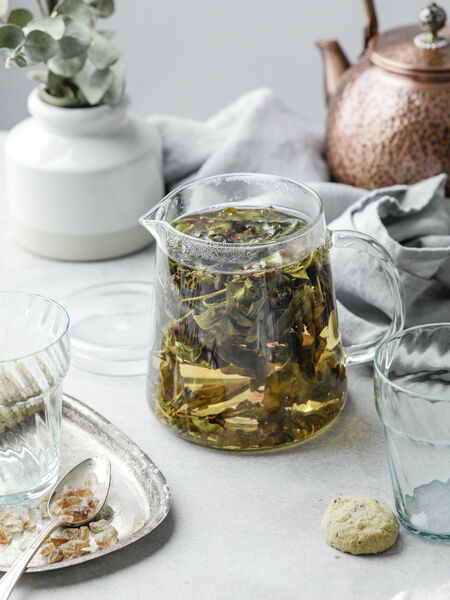Beginner’s Guide to Grandpa Style Brewing


Maybe you’re new to tea and are still trying to get the hang of brewing the perfect cup. Or maybe you’re a regular tea expert, but you’re still on the lookout for new styles of brewing. Whichever describes you, both tea beginners and experts should give Grandpa Style Brewing a try!
Also known as Grampa Style (either spelling is acceptable), Grandpa Style Brewing is a popular form of brewing tea in China that is very casual and one of the easiest methods of brewing tea. No stressing about brewing time or what to do with a used infuser: simply brew the tea leaves in the cup you intend to enjoy tea in.
While this might fly in the face of everything you know about brewing tea (you mean you just leave the leaves in the water the entire time?!), this style of brewing is a great way to extract more flavor out of milder tea leaves. So, let’s get brewing the way Grandpa did, shall we?
What Teas Can Be Used?
White, yellow, and green teas are often chosen for Grandpa Brewing. While oolongs, pu-erhs, and black teas are lovely for brewing styles like gong-fu, they’re not the best choice for Gandpa Style Brewing, mainly because of their stronger flavors and a larger amount of tea needed.
This style of brewing is popular in China, so it’s no surprise that Chinese teas are best suited for this style of brewing (and not just for authenticity’s sake). When it comes to brewing, Chinese teas are very forgiving and don’t “overbrew” or turn bitter easily. The tea Hou Kui (which, unlike most loose teas, comes in large, flattened leaves four or five inches long) is a popular choice in Grandpa brewing for its nice, mild flavor. Additionally, if you have any teas that you think have a weak flavor, try brewing them Grandpa Style so you can extract more flavors from the tea leaves.
Not all teas are suited for Grandpa Brewing and are best brewed with an infuser that is removed once brewing is complete. Japanese green teas like Sencha or Gyokuro, for example, are best saved for a kyusu rather than brewed Grandpa Style: they have small tea particles that can be easily sipped up in Grandpa Brewing and can turn bitter if left in hot water for an extended period of time.
Author’s Tip: I would also avoid any strong-tasting teas for Grandpa Brewing (unless you like strong tea, of course). For example, I enjoy Gunpowder when brewed for two minutes and removing the leaves after, but I found the smokey flavors overpowering when brewed Grandpa Style. For this style of brewing, I recommend mild teas, especially for beginners.
How To Brew
All you need to brew Grandpa Tea is a large cup or mug (this porcelain cup would work wonderfully; just save the infuser for another time), some tea leaves, and hot water. When it comes to the amount of tea leaves, I usually use a teaspoon of loose tea or (with the case of large leaf teas like Hou Kui) 3-4 leaves.
1. Pour the leaves into the large mug. Classic loose tea will fill the bottom of the mug, but something like Hou Kui might stick up out of the mug: that is perfectly fine since the water will cause the leaves to soften and sink back into the mug.
2. Pour hot water into the mug. If using a kettle, use a water temperature suitable for the tea leaves for first time brewing: green teas are prepared with water at 175 degrees Fahrenheit while something like white teas brew ideally at 185 degrees Fahrenheit. Experiment with the ideal temperature for your tea leaves.
3. Let it brew. Some like to cover their mug or cup with a lid to keep the heat from escaping during the brewing process, but you can leave your mug open as well. You can let the tea brew five minutes, ten minutes, twenty minutes. Whatever your tea heart desires!
4. Sip Directly From the Cup. Once the tea has cooled to a drinkable temperature, sip and enjoy. No need to take the leaves out from the cup; the tea will continue to brew as you enjoy it, continually extracting flavors.
5. Refill the cup when it gets anywhere from a third to half full. Tea drinkers online like to leave an allowance of anywhere between 30% to 50% of the tea left in the mug before refilling with hot water. Any less and the flavor will be lost in future cups (plus, you’ll get all the bitterness of the tea).
6. (Optional) Add more leaves if the flavor starts waning. If you notice the flavor starts to fade and you’re not done drinking tea, feel free to add a little more tea to the cup. This isn’t an exact science: a couple of leaves (or one large leaf) will do the trick.
7. Repeat until you’ve had enough or the flavor is gone. This part is up to you! Keep refilling your cup as you please! And when you’re finishing your final cup, just drink what’s left.
